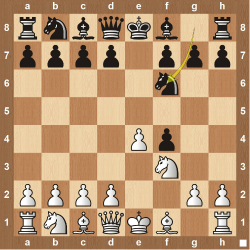
The Schallop Defense is a common line for black in the King’s Gambit and begins with the moves:
1. e4 e5
2. f4 exf4
3. Nf3 Nf6
4. e5 (most common reply from white)
The most common reply after Nf6 is for white to push forward with 4. e5. This forces the black knight to move, removes the white pawn from harm’s way, and keeps white with the initiative. That is something very important for white to constantly do when playing the King’s Gambit.
Black will generally respond by moving the knight to either h5, e4, or d5.
4…Nh5
This move allows black to defend the pawn on f4. White is usually going to push the d-pawn at some point and attack the pawn on f4 with the dark square bishop. It becomes difficult with the black knight on h5 defending the black pawn on f4. Since white will have a difficult time taking the f4 pawn, or removing the knight on h5 right now, it’s best to continue with a game plan of controlling the center and developing attacking pieces.
White will now play 5. d4. If they try to push their own d pawn white can respond with either 5…d5 6. Be2 or 5…d6 6. Bc4.
If they try to be more aggressive and play 5…g5 the white should push forward with 6. h4. This follows the same path that a normal King’s Gambit would go. White is looking to bring the knight no f3 to the new outpost on g5.
4…Nd5
White should attack the knight on d5. It is no longer defending the pawn on f4 so after white chases the knight away they will be able to play d4 and then attack the pawn on f4 with the dark square bishop.
4…Ne4
This is a futile attempt by black to keep the knight active. Since white can’t take the knight right away, and it poses no real through, white should continue to develop the center of the board and get more attacking pieces in the game.
First step is 5. d4. This controls the center and allows the dark square bishop on c1 to attack the pawn on f4. Most of the replies from black on move 5 while be met with 6.Bxf4 from white.
Below you can watch all of the lines referenced on this page and see a much deeper analysis on the Schallop Defense.